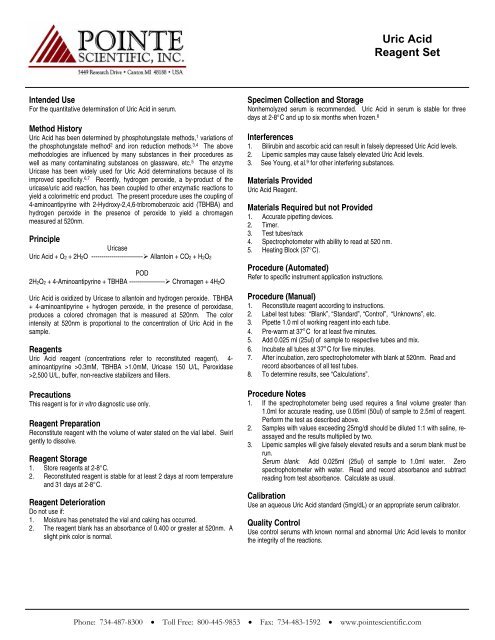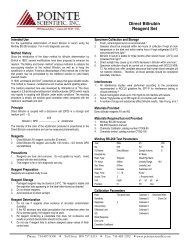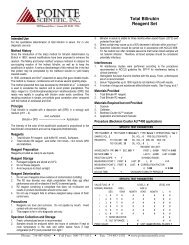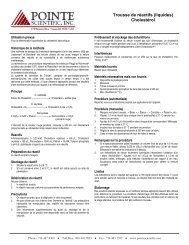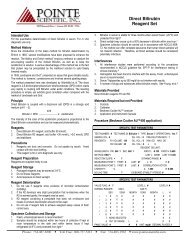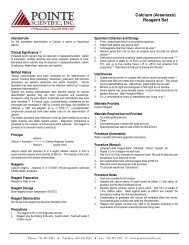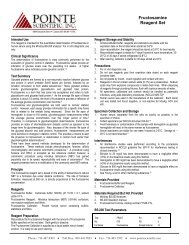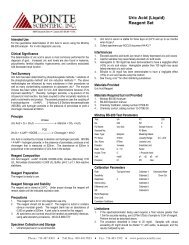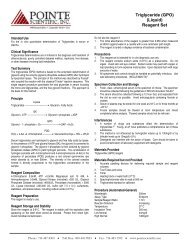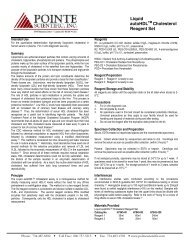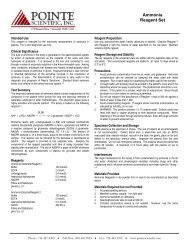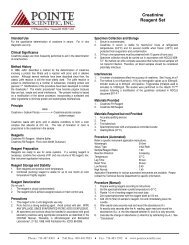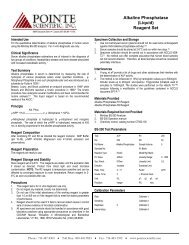Uric Acid Reagent Set - Pointe Scientific, Inc.
Uric Acid Reagent Set - Pointe Scientific, Inc.
Uric Acid Reagent Set - Pointe Scientific, Inc.
You also want an ePaper? Increase the reach of your titles
YUMPU automatically turns print PDFs into web optimized ePapers that Google loves.
Intended Use<br />
For the quantitative determination of <strong>Uric</strong> <strong>Acid</strong> in serum.<br />
Method History<br />
<strong>Uric</strong> <strong>Acid</strong> has been determined by phosphotungstate methods, 1 variations of<br />
the phosphotungstate method 2 and iron reduction methods. 3,4 The above<br />
methodologies are influenced by many substances in their procedures as<br />
well as many contaminating substances on glassware, etc. 5 The enzyme<br />
<strong>Uric</strong>ase has been widely used for <strong>Uric</strong> <strong>Acid</strong> determinations because of its<br />
improved specificity. 6,7 Recently, hydrogen peroxide, a by-product of the<br />
uricase/uric acid reaction, has been coupled to other enzymatic reactions to<br />
yield a colorimetric end product. The present procedure uses the coupling of<br />
4-aminoantipyrine with 2-Hydroxy-2,4,6-tribromobenzoic acid (TBHBA) and<br />
hydrogen peroxide in the presence of peroxide to yield a chromagen<br />
measured at 520nm.<br />
Principle<br />
<strong>Uric</strong>ase<br />
<strong>Uric</strong> <strong>Acid</strong> + O2 + 2H2O --------------------------� Allantoin + CO2 + H2O2<br />
POD<br />
2H2O2 + 4-Aminoantipyrine + TBHBA ------------------� Chromagen + 4H2O<br />
<strong>Uric</strong> <strong>Acid</strong> is oxidized by <strong>Uric</strong>ase to allantoin and hydrogen peroxide. TBHBA<br />
+ 4-aminoantipyrine + hydrogen peroxide, in the presence of peroxidase,<br />
produces a colored chromagen that is measured at 520nm. The color<br />
intensity at 520nm is proportional to the concentration of <strong>Uric</strong> <strong>Acid</strong> in the<br />
sample.<br />
<strong>Reagent</strong>s<br />
<strong>Uric</strong> <strong>Acid</strong> reagent (concentrations refer to reconstituted reagent). 4aminoantipyrine<br />
>0.3mM, TBHBA >1.0mM, <strong>Uric</strong>ase 150 U/L, Peroxidase<br />
>2,500 U/L, buffer, non-reactive stabilizers and fillers.<br />
Precautions<br />
This reagent is for in vitro diagnostic use only.<br />
<strong>Reagent</strong> Preparation<br />
Reconstitute reagent with the volume of water stated on the vial label. Swirl<br />
gently to dissolve.<br />
<strong>Reagent</strong> Storage<br />
1. Store reagents at 2-8°C.<br />
2. Reconstituted reagent is stable for at least 2 days at room temperature<br />
and 31 days at 2-8°C.<br />
<strong>Reagent</strong> Deterioration<br />
Do not use if:<br />
1. Moisture has penetrated the vial and caking has occurred.<br />
2. The reagent blank has an absorbance of 0.400 or greater at 520nm. A<br />
slight pink color is normal.<br />
<strong>Uric</strong> <strong>Acid</strong><br />
<strong>Reagent</strong> <strong>Set</strong><br />
Specimen Collection and Storage<br />
Nonhemolyzed serum is recommended. <strong>Uric</strong> <strong>Acid</strong> in serum is stable for three<br />
days at 2-8°C and up to six months when frozen. 8<br />
Interferences<br />
1. Bilirubin and ascorbic acid can result in falsely depressed <strong>Uric</strong> <strong>Acid</strong> levels.<br />
2. Lipemic samples may cause falsely elevated <strong>Uric</strong> <strong>Acid</strong> levels.<br />
3. See Young, et al. 9 for other interfering substances.<br />
Materials Provided<br />
<strong>Uric</strong> <strong>Acid</strong> <strong>Reagent</strong>.<br />
Materials Required but not Provided<br />
1. Accurate pipetting devices.<br />
2. Timer.<br />
3. Test tubes/rack<br />
4. Spectrophotometer with ability to read at 520 nm.<br />
5. Heating Block (37°C).<br />
Procedure (Automated)<br />
Refer to specific instrument application instructions.<br />
Procedure (Manual)<br />
1. Reconstitute reagent according to instructions.<br />
2. Label test tubes: “Blank”, “Standard”, “Control”, “Unknowns”, etc.<br />
3. Pipette 1.0 ml of working reagent into each tube.<br />
4. Pre-warm at 37°C for at least five minutes.<br />
5. Add 0.025 ml (25ul) of sample to respective tubes and mix.<br />
6. <strong>Inc</strong>ubate all tubes at 37°C for five minutes.<br />
7. After incubation, zero spectrophotometer with blank at 520nm. Read and<br />
record absorbances of all test tubes.<br />
8. To determine results, see “Calculations”.<br />
Procedure Notes<br />
1. If the spectrophotometer being used requires a final volume greater than<br />
1.0ml for accurate reading, use 0.05ml (50ul) of sample to 2.5ml of reagent.<br />
Perform the test as described above.<br />
2. Samples with values exceeding 25mg/dl should be diluted 1:1 with saline, reassayed<br />
and the results multiplied by two.<br />
3. Lipemic samples will give falsely elevated results and a serum blank must be<br />
run.<br />
Serum blank: Add 0.025ml (25ul) of sample to 1.0ml water. Zero<br />
spectrophotometer with water. Read and record absorbance and subtract<br />
reading from test absorbance. Calculate as usual.<br />
Calibration<br />
Use an aqueous <strong>Uric</strong> <strong>Acid</strong> standard (5mg/dL) or an appropriate serum calibrator.<br />
Quality Control<br />
Use control serums with known normal and abnormal <strong>Uric</strong> <strong>Acid</strong> levels to monitor<br />
the integrity of the reactions.<br />
Phone: 734-487-8300 • Toll Free: 800-445-9853 • Fax: 734-483-1592 • www.pointescientific.com
NOTE: Lipemic controls may give falsely elevated results. Follow step #3 of<br />
“Procedure Notes”.<br />
Calculations<br />
A = Absorbance<br />
A (Unk) x Conc. of Std. = <strong>Uric</strong> <strong>Acid</strong> (mg/dL)<br />
A (Std)<br />
Example: unknown A (Unk) =0.126, A (std)= 0.100, Conc. of Std = 5 mg/dL.<br />
Then: 0.126 x 5 = 6.3 mg/dL<br />
0.100<br />
SI Units (mM/L)<br />
Multiply the result (mg/dL) by 10 to convert dL to L and divide by 168 (the<br />
molecular weight of <strong>Uric</strong> <strong>Acid</strong>).<br />
mg/dL x 10 = mM/L mg/dL x .0595 = mM/L<br />
168<br />
Example: 6.3mg/dL x .0595 = 0.375mM/L<br />
Expected Values<br />
2.5-7.7mg/dl 8<br />
It is strongly recommended that each laboratory establish its own normal<br />
range.<br />
Performance<br />
1. Linearity: 25 mg/dL<br />
2. Comparison: Testing with another similar enzymatic <strong>Uric</strong> <strong>Acid</strong><br />
procedure yielded a correlation coefficient of .996 with a regression<br />
equation of y=1.03x-0.34.<br />
3. Precision:<br />
Within Run Run to Run<br />
Mean S.D. C.V.% Mean S.D. C.V.%<br />
6.58 0.13 1.9 6.78 0.11 1.6<br />
10.91 0.16 1.3 11.34 0.14 1.2<br />
<strong>Uric</strong> <strong>Acid</strong><br />
<strong>Reagent</strong> <strong>Set</strong><br />
References<br />
1. Folin, D., Dennis, W., J. Biol. Chem. 13:469 (1913).<br />
2. Caraway, W.T., Clin. Chem. 4:239 (1963).<br />
3. Morin, L.G., J. Clin. Path. 60:691 (1973).<br />
4. Morin, L.G., Clin. Chem. 20:51 (1974).<br />
5. Brochner-Mortenson, K., Medicine 19:161 (1940).<br />
6. Klackar, H.M., J. Biol. Chem. 167:429 (1947).<br />
7. Praetorius, E., Poulson, H., Scand. J. Clin. Invest 5:273 (1953).<br />
8. Henry, R.J., Clinical Chemistry: Principles and Technics, 2 nd Ed.,<br />
Hagerstown (MD), Harper & Row, pp.531 &541 (1974).<br />
9. Young, D.S., et al. Clin. Chem. 21:1D (1975).<br />
Manufactured by <strong>Pointe</strong> <strong>Scientific</strong>, <strong>Inc</strong>.<br />
5449 Research Drive, Canton, MI 48188<br />
European Authorized Representative:<br />
Obelis s.a.<br />
Boulevard Général Wahis 53<br />
1030 Brussels, BELGIUM<br />
Tel: (32)2.732.59.54 Fax:(32)2.732.60.03 email: mail@obelis.net<br />
Rev. 12/09 P803-U7580-02


